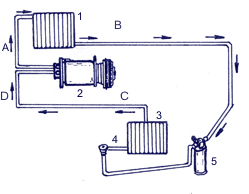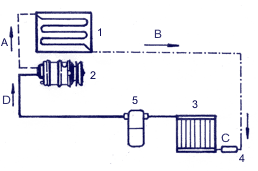

| NEWS | |||||||
| ABOUT | |||||||
| PRODUCTS AND SERVICES | |||||||
|
| |||||||
| PLACE AN ORDER | |||||||
| DOWNLOAD | |||||||
| HELPFUL HINTS | |||||||
| FAQ | |||||||
| LINKS | |||||||
| SEARCH | |||||||
| SITE MAP | |||||||
| CONTACT | |||||||
| русский |
WHAT IS AIR-CONDITIONER
Refrigerant circulates through the line of closed contour and its components. Refrigerant needs to repeat such cycles continuously, and it is called the refrigerant cycle. Phenomena which occur depending on refrigerant circulating within the cycle are connected with changing of each pressure and temperature value while refrigerant transformation into gas and condensation into liquid again. Refrigerating system is based on several constant physical principles. Such principles flow from the discussion on which phenomena are produced by the refrigerant while operating of the refrigerating system. Refrigerant gas is absorbed and compressed by compressor up to high temperature and pressure (80°С, 15 kg/smg) and afterwards released. Refrigerant released from compressor goes into condenser and is deliberately cooled by the cooling system fan, giving away at the same time latent condensation heat to the air going through condenser, transforms into liquid. Temperature at this moment is about 50°С. Refrigerant transformed into liquid after removal of moisture and dust in receiver-drier goes to expansion valve.
High pressure liquid refrigerant in the expansion valve when sharply expanding transforms into low temperature and pressure fog-like refrigerant (-2°С, 2.0 kg/sm2), such refrigerant then flows to evaporator. Refrigerant in the fog-like state when entering the evaporator and going through the fan, taking away latent evaporation heat from the compressed air cools down the air in the surroundings. Simultaneously with cooling it is transformed from the fog-like state into gaseous state and absorbed by the compressor for the repeated cycle. In the same way refrigerant when repeating circulation along the cycle performs cooling. In general, in order to transform gas into liquid, it is enough to pump pressure, but in order to facilitate transformation into liquid they also cool down along with pressure pumping. For this purpose there are needed compressor and condenser in modern refrigerating facilities. There exist two typical air-conditioning schemes which differ just slightly. Organizing the state of refrigerant on each component inside refrigerating cycle of the above-mentioned system, it looks in the following way, like in the table.
|

